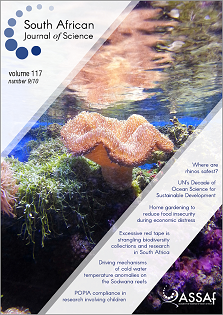Dynamics of rice production among the food crops of Tanzania
DOI:
https://doi.org/10.17159/sajs.2021/11020Keywords:
rice production, compound annual growth rate, instability, Markov chain, TanzaniaAbstract
Rice is an important crop in Tanzania which contributes significantly to the farmers, consumers, and the government. Recognising this importance, the government has made initiatives to attain rice self-sufficiency. These initiatives are crucial in contributing to regional self-sufficiency, enabling rice market leadership, and injecting productivity through significant improvements in the quality, quantity, and value of rice produced in Tanzania. We investigated the dynamics of rice area, production, and productivity and identified shifts in the land-use patterns in Tanzania. To analyse secondary data collected over a 33-year period from 1986/1987 to 2018/2019, we used compound annual growth rates, Cuddy-Della Valle Index and a first-order Markov chain approach. We found that the growth in the areas under rice cultivation, production and productivity were inconsistent as evidenced by the presence of instabilities. Rice remains the third most stable crop in the country in terms of area under production retention; however, this might decline in the next 2 years. Policies in future must enable strategies to increase productivity as well as promote high-yielding varieties, efficient input usage, and irrigation infrastructure development.
Significance:- We investigated the spatial and temporal trends in rice area, production, and productivity as well as identified shifts in the crop land-use patterns after a series of government interventions. To achieve sustainability, it is essential to revisit agricultural crop growth strategies regularly at macro- and micro-levels.
Published
Issue
Section
License

This work is licensed under a Creative Commons Attribution 4.0 International License.

All articles are published under a Creative Commons Attribution 4.0 International Licence
Copyright is retained by the authors. Readers are welcome to reproduce, share and adapt the content without permission provided the source is attributed.
Disclaimer: The publisher and editors accept no responsibility for statements made by the authors
How to Cite
- Abstract 501
- PDF 2116
- EPUB 157
- XML 154












.png)